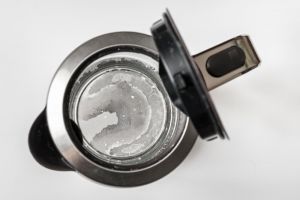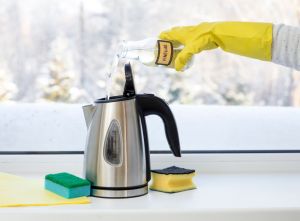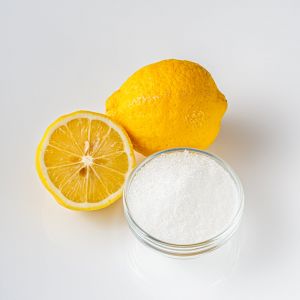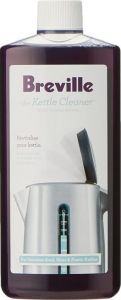On this page:
What is limescale?
Limescale is that hard, chalky deposit that builds up inside kettles, coffee machines, boilers, and pipes in your kitchen and bathroom. It’s always more visible on stainless steel and metallic parts, but you may also find limescale residue on dishes you’ve washed with hot water and even on your clean laundry.

What causes limescale?
Limescale is a result of a build-up of calcium and magnesium minerals left behind when hard water evaporates. Limescale is more prevalent anywhere water is heated because calcium carbonate is less soluble in hot water. That’s why you’ll most commonly find limescale in kettles, water heaters, around taps and fixtures, and in the pipework around the home. The build-up of this scale over time can impact the performance and lifespan of your appliances and pipework, and also impact how your water tastes.
Why is limescale a problem?
In addition to being unpleasant and not always easy to clean, limescale and hard water deposits can cause a variety of other issues including:
- Impacting the taste of your water (resulting in a chalky or metallic taste)
- Accumulating on your clothes, dishes, and fixtures
- Damaging or impairing appliances like kettles and washing machines
- Possible restriction of water flow and blockages in pipework over time
- Can reduce the heat transfer efficiency of boilers and cooling water systems
- Increasing your maintenance costs
How often should you descale your kettle & boilers?
As a general rule, you should descale your kettle and boilers (including your coffee machine) once a month. Don’t let limescale build up or it will become more difficult to manage and remove over time. A Canstar Blue survey found that a quarter of people who own a kettle (25%) regularly clean it, whether they see limescale in it or not. As the old adage goes, prevention is the best protection. How often you descale your kettle and boilers will also depend on how much you use them, and on the hardness of the water in your area.
You might also like:
- Fast-boiling kettles guide
- Glass vs stainless steel kettle: Which is best?
- How many watts does a kettle use?
How to remove limescale from your kettle
There are three ways to remove limescale from your kettle and boilers, either using a natural DIY solution, citric acid, or a store-bought descaler. Whichever method you choose, be sure to remove as much free-floating limescale as you can before you start, and use a soft-bristled brush or sponge to scrub away any mineral build-up that remains inside. Be sure not to damage any internal coating.
Use a natural limescale remover – The best method

The best way to remove limescale from your kettle is to make your own natural limescale remover with vinegar, bicarbonate soda (bicarb soda), and water. You can also use this mixture for cleaning your air fryer basket, washing machine, shower, etc. This DIY method is also the cheapest and most environmentally-friendly option. Follow these steps:
- Fill your kettle ¾ of the way with water, add a heaped tablespoon of bicarb soda and half a cup of distilled white vinegar
- Boil the kettle
- Allow the mixture to soak for an hour
- Pour out the mixture and rinse
- Fill and boil the kettle again with just water to remove any bicarb soda residue.
Read more: How to clean your air fryer (cleaning hacks)
Use citric acid – The fuss-free method

Citric acid (a compound derived from lemon juice) isn’t just used for cooking or baking, it’s also super effective at removing soap scum, grime, calcium deposits, and rust. It’s often used as a mild cleaning agent much like vinegar. You can buy citric acid from most supermarkets for under $5. Follow these steps:
- Fill your kettle with one tablespoon of citric acid powder and one cup of hot water
- Boil the kettle
- Allow the mixture to soak for an hour
- Pour out the mixture and rinse
- Fill and boil the kettle again with just water to remove any acidic residue.
Use a commercial descaler – Not always the best method

You can also descale your kettle using commercial limescale remover or descaler products which you can buy for under $10 from most supermarkets and hardware stores like Bunnings. There are products in the market that are specifically dedicated to removing limescale from coffee machines, kettles, and washers. Appliance brand Breville sells a kettle cleaner for $9 available from Woolworths. Just keep in mind that commercial descalers may contain chemicals or compounds that a) may corrode the inside of your kettle over time and b) that you don’t necessarily want to use in appliances or pipes that provide your drinking water. When in doubt, do your research. Follow these steps:
- Follow the manufacturer’s instructions carefully as some limescale removers need to be diluted with water, while others have a milder formula
- Fill your kettle with the recommended solution and water (no more)
- Boil the kettle
- Allow the mixture to soak for the recommended time (usually 20 minutes)
- Fill and boil the kettle again with just water to remove any chemical residue.
Clean the filters
Don’t forget to clean your kettle’s filter and the same goes for your coffee machine. You’d be surprised by how much limescale builds up in filters over time. If your appliance comes with a removable filter, take it out and soak it in the sink with some distilled white vinegar and water for about 30 minutes. Use a gentle scrubber to clean off any limescale left over and voila!
Is limescale safe to drink?
Yes, limescale is safe to ingest, although that chalky taste that comes with it can be unpleasant and really spoil your morning coffee or tea. Limescale can also impair the performance of your trusty appliances over time. You can use your kettle as normal even if there’s a limescale build-up inside. In fact, the World Health Organisation (WHO) suggests there may even be health benefits to limescale in helping you meet your daily mineral requirements and for bone density. Take this with a grain of salt, but the gist is that limescale is not harmful to drink.
How to prevent limescale build-up in your kettle
While there’s no way to prevent limescale build-up altogether, there are ways to slow it down. Always dry your kettle after each use, instead of letting water pool at the bottom. You can also buy a water filtration system (also known as a water softener) that removes high concentrations of minerals like calcium and magnesium in your water. This will cost you a few hundred dollars, but it’s well worth the investment. This will also improve the taste of your drinks as hard water can be quite metallic.
How to clean the outside of your kettle
You should give the outside of your kettle a wipe-down every week or so to remove grime and finger marks. Follow these steps:
- If you’ve got an electric kettle, be sure to keep liquids away from electrical elements and sockets (turn off the appliance at the wall for safety)
- Spray a cloth with a multi-purpose cleaner or vinegar, or use multi-surface wipes (for glass kettles)
- Wipe the kettle all over to remove grime, finger marks, and water residue
- Clean the spout and lid after you’ve descaled the kettle.
Smart tip: If you’ve got a stainless steel kettle, coat it with a smidge of baby oil or olive oil to give it a streak-free finish. You can also do this with your kitchen sink.



Share this article